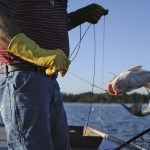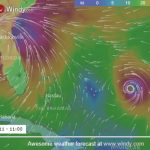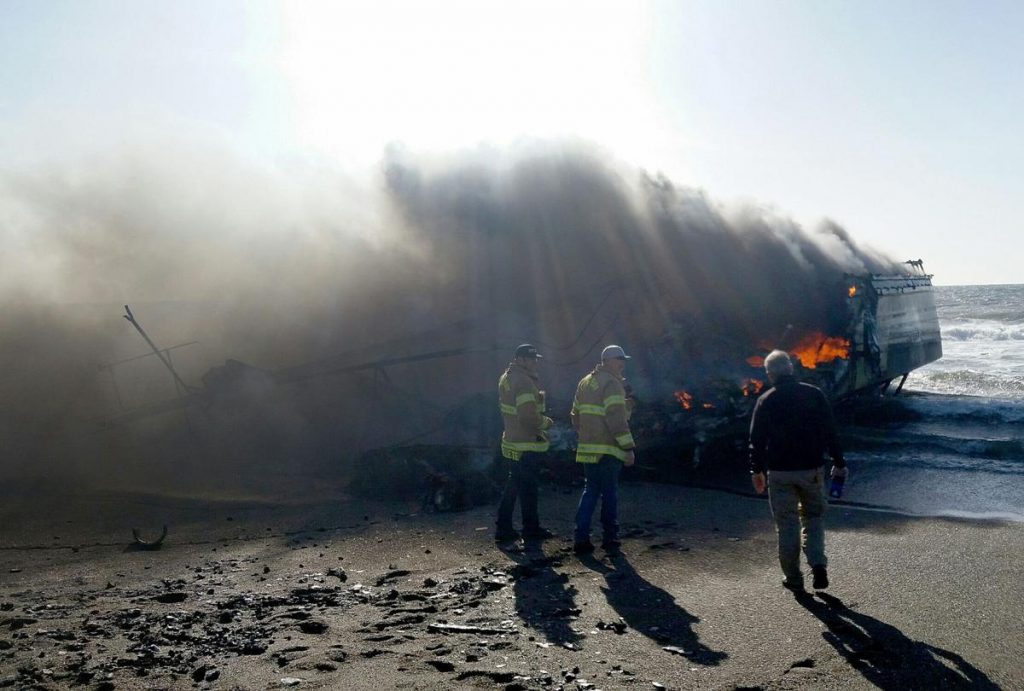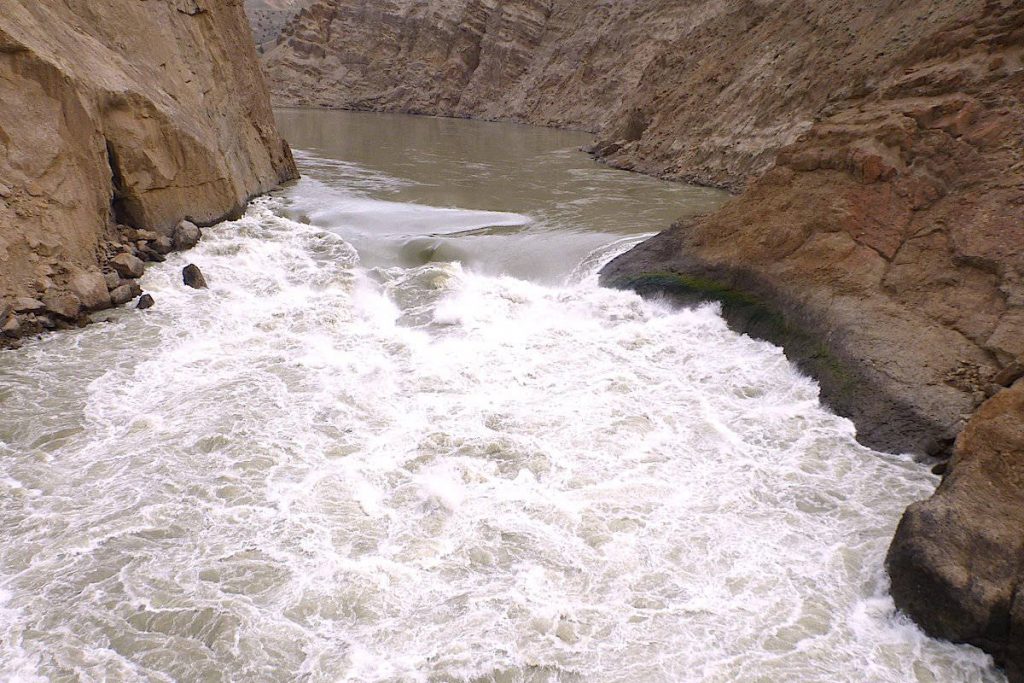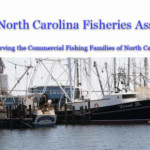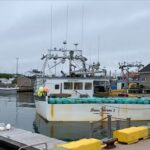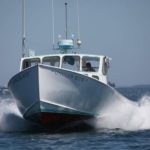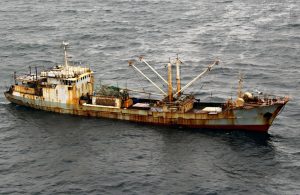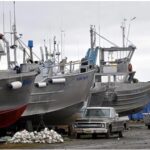Tag Archives: U.S. Navy
WWII Veteran/Retired Commercial Fisherman Charles Lee Wescott of Wanchese, NC, has passed away
 Charles Lee Wescott, a 105-year-old native of Wanchese, North Carolina, departed his Earthly home in Wanchese, North Carolina, on February 21, 2024, with his family at his side. Charles was born September 27, 1918, in Gum Neck, Tyrrell County, North Carolina, the eldest child born to Theophilus Lee Wescott and Ina Cahoon Wescott. Charles joined the U.S. Coast Guard in 1940 before the United States entered the WW-II efforts in 1941. During WW II, he was assigned to the U.S. Navy. Before Charles’ death, the U.S. Department of Veterans Affairs confirmed Charles to be the oldest surviving WW-II Veteran in The State of North Carolina. Charles devoted his life to being a commercial fisherman, from which he retired. He was one of the first charter boat captains out of Oregon Inlet Fishing Center in the 1950s. He owned and managed his boat, the Myrtle W., affectionally named after his wife. more, >>CLICK TO READ<< 16:35
Charles Lee Wescott, a 105-year-old native of Wanchese, North Carolina, departed his Earthly home in Wanchese, North Carolina, on February 21, 2024, with his family at his side. Charles was born September 27, 1918, in Gum Neck, Tyrrell County, North Carolina, the eldest child born to Theophilus Lee Wescott and Ina Cahoon Wescott. Charles joined the U.S. Coast Guard in 1940 before the United States entered the WW-II efforts in 1941. During WW II, he was assigned to the U.S. Navy. Before Charles’ death, the U.S. Department of Veterans Affairs confirmed Charles to be the oldest surviving WW-II Veteran in The State of North Carolina. Charles devoted his life to being a commercial fisherman, from which he retired. He was one of the first charter boat captains out of Oregon Inlet Fishing Center in the 1950s. He owned and managed his boat, the Myrtle W., affectionally named after his wife. more, >>CLICK TO READ<< 16:35
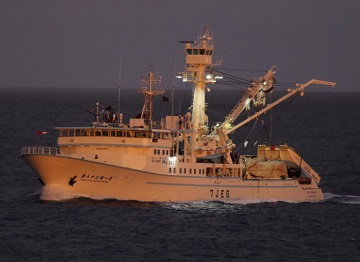
U.S. Coast Guard, Japanese Coast Guard and U.S. Navy medevacs fisherman off Guam
Members of the U.S. Coast Guard, Japan Coast Guard, and U.S. Navy rescued a mariner aboard a fishing vessel south of Guam. On Tuesday, June 7, 2022, U.S. Coast Guard Forces Micronesia/Sector Guam’s Joint Rescue Sub-Center (JRSC) received a report of a 55-year old male experiencing severe abdominal pain aboard F/V Fukuichimaru No. 83, nearly 725-nautical miles south of Guam. Photos, >click to read< 22:05
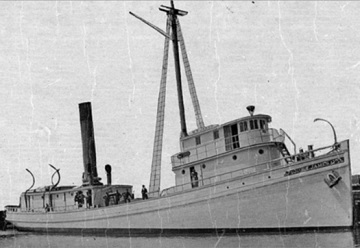
How the U.S. Fishing Fleet Served the Navy and Coast Guard in WWII
In the early days of World War II, demand skyrocketed for vessels to fill the needs of the U.S. sea services. The Coast Guard was no exception as they competed with the U.S. Navy and U.S. Army for new construction as well as privately owned ships. Facing a high demand for vessels, the service turned to the U.S. fishing industry as a source for its cutters. These emergency acquisitions included East Coast trawlers, whalers from both coasts, and East Coast menhaden fishing vessels, such as the Emergency Manning vessel Dow (WYP 353). During World War I and World War II, the menhaden fishing fleet became a ready reserve for the Navy and Coast Guard. Both services needed small, shallow draft vessels for coastal convoy escort, mine planting, minesweeping, and anti-submarine net tending duty. Many of these vessels were purchased or leased, while others were loaned to naval forces by fishing businesses as their contribution to the war effort. >click to read< 18:28

Obituary: Nathan Fuller, World War II – Korean War Navy Veteran, Lobsterman has passed away
Nathan Fuller, 94, passed away peacefully at Pen Bay Medical Center, with family by his side. Born in St. George June 24, 1926, he was one of four children born to Seymour and Elvie Chaples Fuller. In 1942, Nate lied about his age and enlisted in the Navy. On Dec. 30, 1957, he married the love of his life, Thelma Alley, and they enjoyed 63 happy years together. The second love of his life was lobstering. During his lobstering career, he had seven lobster boats built, and on the day his last lobster boat was sold and picked up by the new owner, he offered to “buy it back” for a higher price. >click to read< 16:25
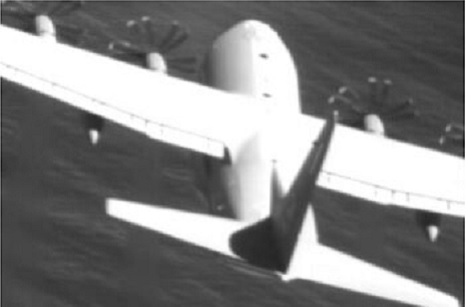
Video: U.S. Coast Guard, Air Force, and Navy medevac fisherman from commercial fishing vessel off Hawaii
The Coast Guard, Air Force, and Navy successfully medevaced a 73-year-old fisherman from the 84-foot commercial fishing vessel Lady Alice 150 miles east of Hilo, Friday. At 7:37 a.m., Monday, the owner of the Lady Alice notified JRCC watchstanders that the master of the vessel appeared to be suffering symptoms of a stroke. The mariners aboard provided medication to the patient and were instructed by JRCC watchstanders to monitor his condition and maintain scheduled communication. Duty flight surgeons from the Coast Guard and Air Force were consulted and recommended sending Air Force pararescue jumpers from the 129th Rescue Wing to the vessel before the mariner’s condition deteriorated. Video >click to read< 10:22

Coast Guard says it will continue rescues near wind farms
State Sen. Susan Sosnowski said last week that the U.S. Coast Guard will continue to conduct its search-and-rescue missions in and near wind farms.,, The Coast Guard confirmed the information last week as well.,, Two other agencies, the U.S. Navy and the Federal Aviation Administration, also responded to the task force’s concerns relating to the displacement of vessel traffic, collision risks and radar interference. >click to read< 07:44
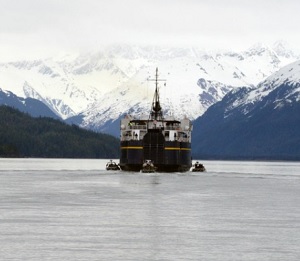
“Northern Edge” – Alaskans at war with U.S. military over readiness exercises
The air in Cordova, Alaska, is an unlikely mix of fresh glacial air and diesel fuel fumes. On one side of the isolated town rise the Chugach Mountains; on the other, a worn-looking fleet of fishing boats float in Prince William Sound, a northern branch of the Gulf of Alaska. There are no roads in or out of Cordova, and more than half of its 2,000-plus residents depend on the salmon industry. But for two weeks this May, their way of life could be under fire — literally. >click to read<08:20
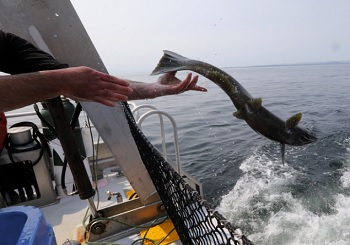
Dosed salmon, clipped fins, a ‘dinner bell’: How far is too far in helping starving orca?
The emergency effort to save a critically ill orca whale is an experiment without precedent. An international team of scientists is piloting techniques to treat a wild, free-swimming orca, one of the largest predators on Earth. The effort includes serving up live fish pumped with medicine and playing a unique tone that one researcher likened to a “dinner bell.” A federal permit approved Aug. 8 provides the clearest look yet at the details of an operation that raises questions even for those involved about the proper limits of human intervention. >click to read<17:39
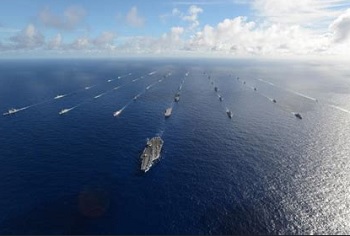
RIMPAC battle lines forming – “They bomb right where we fish,”
It’s the 26th exercise since RIMPAC began in 1971 and the third iteration of the Oceans4Peace Coalition, which works to turn the heads of the public and Legislature against the exercise. “We are committed to educating the public about the Navy’s war games and their impacts on the ocean and our islands,” organizer Gordon LaBedz told TGI before the meeting.,, Shyla Moon, Kauai adviser for the Western Pacific Fishery Management Council, said fishermen are concerned about the impacts to stocks during and after RIMPAC. “They bomb right where we fish,” she said. >click to read<09:51
Alaska fishermen lobby Navy to delay training exercises scheduled for May
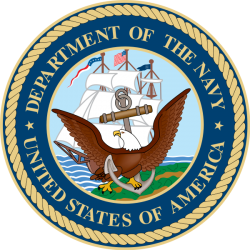 The required permits are not yet in hand but the U.S. Navy is moving ahead on plans to conduct war training exercises in the Gulf of Alaska for two weeks in early May. Meanwhile, nine coastal communities have signed resolutions asking the Navy to instead conduct its training between September and mid-March, less-sensitive times for migrating salmon, birds and marine mammals. “It’s not that we don’t want the Navy to do their training — it’s the time and locations,” said Emily Stolarcyk, program director for the Eyak Preservation Council of Cordova. “The community resolutions say that we are the people who depend on commercial, subsistence and recreational fishing,” she added. “The Navy exercises are planned during the most important breeding and migratory periods for salmon, birds, whales and marine mammals. About 90 percent of the training area is designated as essential fish habitat for all five species of Pacific salmon. May is the worst time to be doing this.” continue reading the article here 11:07
The required permits are not yet in hand but the U.S. Navy is moving ahead on plans to conduct war training exercises in the Gulf of Alaska for two weeks in early May. Meanwhile, nine coastal communities have signed resolutions asking the Navy to instead conduct its training between September and mid-March, less-sensitive times for migrating salmon, birds and marine mammals. “It’s not that we don’t want the Navy to do their training — it’s the time and locations,” said Emily Stolarcyk, program director for the Eyak Preservation Council of Cordova. “The community resolutions say that we are the people who depend on commercial, subsistence and recreational fishing,” she added. “The Navy exercises are planned during the most important breeding and migratory periods for salmon, birds, whales and marine mammals. About 90 percent of the training area is designated as essential fish habitat for all five species of Pacific salmon. May is the worst time to be doing this.” continue reading the article here 11:07
Navy to Expand Sonar, Other Training off Northwest Coast
 The U.S. Navy has finalized a plan to expand sonar testing and other warfare training off the coasts of Washington, Oregon and northern California. The Navy decided to implement its preferred plan after a lengthy review that included a determination from the National Marine Fisheries Service that the exercises would not have major impacts on endangered orcas and other marine mammals. It announced its decision on Nov. 4. The fisheries service last year renewed the Navy’s five-year permit, through 2020, to conduct the activities in areas from the inland waters of Puget Sound in Washington state to the northern coast of California. The plan includes expanding the use of “sonobuoys,” devices that send out underwater sonar signals used by air crews training to detect submarines. Read the rest here 16:54
The U.S. Navy has finalized a plan to expand sonar testing and other warfare training off the coasts of Washington, Oregon and northern California. The Navy decided to implement its preferred plan after a lengthy review that included a determination from the National Marine Fisheries Service that the exercises would not have major impacts on endangered orcas and other marine mammals. It announced its decision on Nov. 4. The fisheries service last year renewed the Navy’s five-year permit, through 2020, to conduct the activities in areas from the inland waters of Puget Sound in Washington state to the northern coast of California. The plan includes expanding the use of “sonobuoys,” devices that send out underwater sonar signals used by air crews training to detect submarines. Read the rest here 16:54
Commercial fisherman Jonathon Hoag meets joint team who saved his life
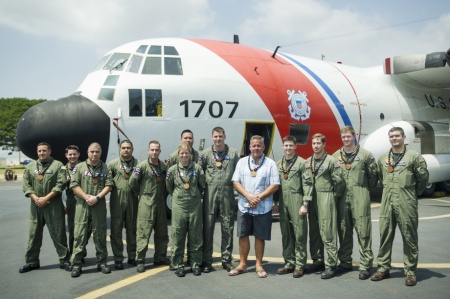 “Who wouldn’t?” Hoag said. “A group of people who saved your life, three lives… to send a post card or a ‘thank you’ note? No, I don’t think so.” After shaking hands and personally thanking those involved in his extraction, Hoag took some time to talk about the rescue. “We were just doing our normal thing, we were fishing,” Hoag said. “It was rougher than usual; we didn’t really fish in the morning because it was so rough. We have a big sea anchor that we use so we just basically rode it out for a while. Later on in the late afternoon it ended up lying down a little bit and we got up to where we fish. The fishing was decent so we fished until just before dark.” On March 11, watchstanders at the Joint Rescue Coordination Center in Honolulu received an emergency distress call that would evolve into the U.S. Coast Guard and U.S. Navy conducting a successful SAR mission to transport Hoag and his two crew members to safety. Read the story, click here 07:03
“Who wouldn’t?” Hoag said. “A group of people who saved your life, three lives… to send a post card or a ‘thank you’ note? No, I don’t think so.” After shaking hands and personally thanking those involved in his extraction, Hoag took some time to talk about the rescue. “We were just doing our normal thing, we were fishing,” Hoag said. “It was rougher than usual; we didn’t really fish in the morning because it was so rough. We have a big sea anchor that we use so we just basically rode it out for a while. Later on in the late afternoon it ended up lying down a little bit and we got up to where we fish. The fishing was decent so we fished until just before dark.” On March 11, watchstanders at the Joint Rescue Coordination Center in Honolulu received an emergency distress call that would evolve into the U.S. Coast Guard and U.S. Navy conducting a successful SAR mission to transport Hoag and his two crew members to safety. Read the story, click here 07:03


































